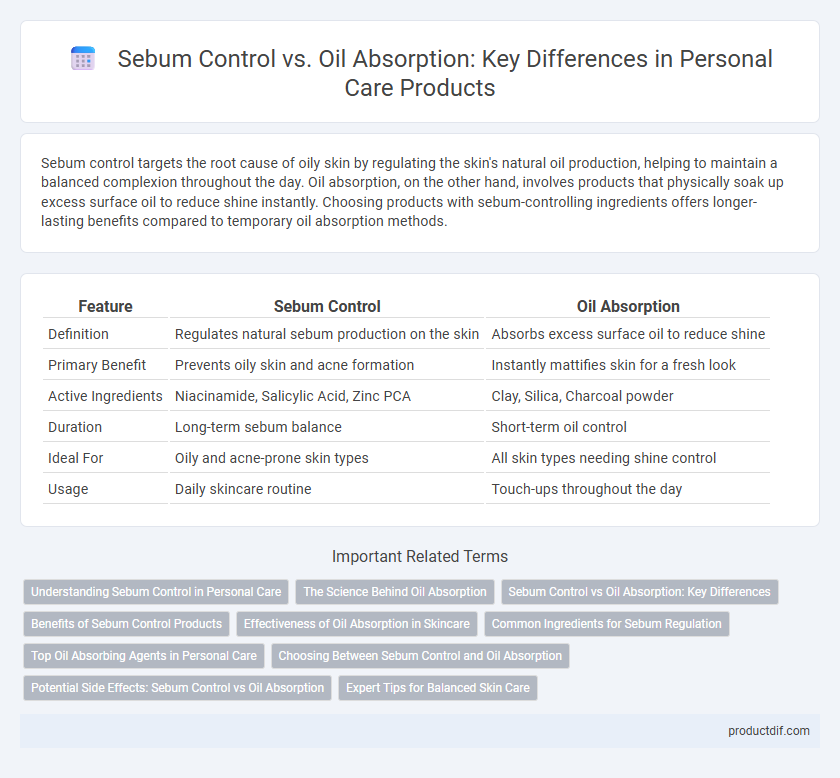Sebum control targets the root cause of oily skin by regulating the skin's natural oil production, helping to maintain a balanced complexion throughout the day. Oil absorption, on the other hand, involves products that physically soak up excess surface oil to reduce shine instantly. Choosing products with sebum-controlling ingredients offers longer-lasting benefits compared to temporary oil absorption methods.
Table of Comparison
| Feature | Sebum Control | Oil Absorption |
|---|---|---|
| Definition | Regulates natural sebum production on the skin | Absorbs excess surface oil to reduce shine |
| Primary Benefit | Prevents oily skin and acne formation | Instantly mattifies skin for a fresh look |
| Active Ingredients | Niacinamide, Salicylic Acid, Zinc PCA | Clay, Silica, Charcoal powder |
| Duration | Long-term sebum balance | Short-term oil control |
| Ideal For | Oily and acne-prone skin types | All skin types needing shine control |
| Usage | Daily skincare routine | Touch-ups throughout the day |
Understanding Sebum Control in Personal Care
Sebum control in personal care products targets the regulation of natural oil production on the skin to prevent excess shine and reduce acne risk. Unlike oil absorption, which relies on ingredients like clay or silica to physically soak up surface oils, sebum control works by balancing oil secretion at its source, promoting healthier skin function. Effective sebum control ingredients include niacinamide, zinc PCA, and salicylic acid, which help maintain skin clarity and prevent clogged pores without over-drying.
The Science Behind Oil Absorption
Oil absorption in personal care products involves materials like silica and clay that physically trap and lift excess sebum from the skin surface. Sebum control, however, refers to regulating the skin's natural oil production through ingredients such as niacinamide and salicylic acid to reduce overactivity of sebaceous glands. Understanding the science behind oil absorption helps in selecting formulations that provide immediate mattifying effects without disrupting skin's natural barrier or causing dryness.
Sebum Control vs Oil Absorption: Key Differences
Sebum control targets the regulation of natural oil production by the skin's sebaceous glands, reducing excess shine and preventing clogged pores. Oil absorption involves the physical removal or binding of surface oils using ingredients like clay or silica to provide immediate matte effects. Effective personal care products balance both mechanisms to maintain skin clarity and prolong a fresh, non-greasy appearance.
Benefits of Sebum Control Products
Sebum control products regulate excess oil production at the skin's source, preventing clogged pores and reducing acne breakouts effectively. Unlike simple oil absorption, these products maintain the skin's natural moisture balance while minimizing shine throughout the day. Benefits include improved skin texture, longer-lasting matte finish, and enhanced overall complexion health for oily and combination skin types.
Effectiveness of Oil Absorption in Skincare
Effective oil absorption in skincare products is crucial for managing excess sebum and preventing shine, leading to a matte complexion throughout the day. Ingredients like silica, kaolin clay, and charcoal are scientifically proven to absorb surface oils without stripping the skin's natural moisture barrier. Choosing formulations with high oil absorption capacity helps reduce acne breakouts and maintains skin balance more efficiently than sebum control alone.
Common Ingredients for Sebum Regulation
Common ingredients for sebum regulation in personal care products include salicylic acid, niacinamide, and zinc oxide, which help to reduce excess oil production and maintain skin balance. Ingredients such as kaolin clay and silica provide effective oil absorption by drawing out surface oils and minimizing shine. Combining sebum-controlling agents with oil-absorbing materials ensures longer-lasting matte skin and reduces the risk of clogged pores and acne.
Top Oil Absorbing Agents in Personal Care
Top oil absorbing agents in personal care effectively reduce skin shine by targeting excess sebum production and surface oil accumulation. Ingredients such as silica, kaolin clay, and starch derivatives absorb oils without disrupting the skin's natural barrier, promoting a matte complexion. These agents enhance the performance of sebum control formulations by maintaining a fresh, non-greasy feel throughout the day.
Choosing Between Sebum Control and Oil Absorption
Sebum control products regulate natural oil production by targeting the skin's sebaceous glands, reducing excessive shine and preventing clogged pores. Oil absorption products focus on absorbing excess surface oil with ingredients like clay or silica, providing instant matte finish without altering underlying sebum levels. Choosing between sebum control and oil absorption depends on whether you need long-term regulation of oil production or quick removal of surface greasiness for immediate appearance improvement.
Potential Side Effects: Sebum Control vs Oil Absorption
Sebum control products actively regulate the skin's natural oil production, which can lead to dryness, irritation, or even overcompensation causing increased oiliness. Oil absorption products, such as mattifying powders or blotting sheets, temporarily remove excess surface oil without affecting sebum production, reducing the risk of dryness or irritation but potentially requiring frequent reapplication. Both methods can impact skin balance differently, making it essential to choose formulations that suit individual skin types to minimize adverse effects like redness or breakouts.
Expert Tips for Balanced Skin Care
Sebum control targets the regulation of excess oil production from sebaceous glands, preventing clogged pores and acne, while oil absorption physically removes surface oil using ingredients like kaolin clay or silica. Experts recommend combining gentle sebum control agents such as salicylic acid with oil-absorbing components to maintain balanced, matte skin without over-drying or irritation. Incorporate lightweight, non-comedogenic formulas alongside regular exfoliation for optimal skin texture and shine reduction.
Sebum control vs oil absorption Infographic

 productdif.com
productdif.com